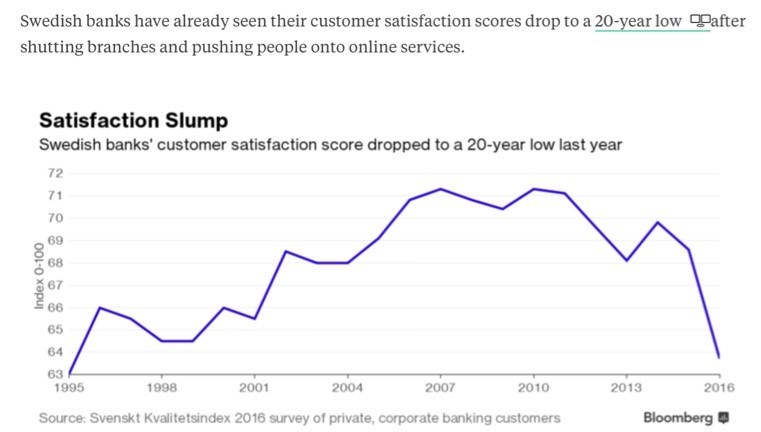“Retail Banking Automation” case study article, was published in the Banker Middle East May 2018 issue 206 edition, because we know that the present dissatisfaction of many retail customers with the Automation of Retail Services in the Banking Sector can be corrected and improved to become equal or better than service by humans, with better automation methods, carefully applied.
(———–)
In this period of very low interest rates, the fact that retail customers are a very good source of low cost capital tends to be overlooked. Banks focus more on the asset side of Retail Banking.
Low interest rates will not last forever. They have already, timidly, started to pick up. The importance of retail customers’ deposits, although individually small, will become, in their entirety, important again.
The depositor is the foundation of Banking.
Retail Customers were neglected by the Banking system, mainly due to the high cost of servicing them. That can now be corrected with the proper use of a number of new technologies, such as AI, Big Data, Fintech and Blockchain, often collectively called, Automation.
Attention must be paid to the fact that, while Wholesale or Private Banking Customers are vocal and feedback on mistakes or inadequate services is received fast, the majority of the Retail Customers are silent, while their problems reach with difficulty the upper echelons of Retail Bank Management.
The recent advances in Automation can facilitate the personalization of Retail Banking without the many problems that exist to date. They can also increase connectivity and on demand Service.
Automation in the processing of Retail Customers’ needs, was wrongly understood by many Banks, as the chosen way to reduce retail customer servicing costs.
 That pleased the Banks but displeased the Retail Customers. The principal reason was and is that the service level of automated Customer Service was lower vs. that of Human Service. In addition, Customers needed to learn new ways to operate their accounts, most of them self-taught. A wave of customer displeasure extended from Sweden to South Africa.
That pleased the Banks but displeased the Retail Customers. The principal reason was and is that the service level of automated Customer Service was lower vs. that of Human Service. In addition, Customers needed to learn new ways to operate their accounts, most of them self-taught. A wave of customer displeasure extended from Sweden to South Africa.
The problem, in general, lies not in Digitalization or Automation, but rather in the way it has been applied by many financial organizations.
The principal source of problems is excessive reliance to external providers and outsourcing of the Automation tasks. This is often done without adequate internal know-how and understanding, to control Provider selection, as well as, monitor the quality of the Providers work; particularly from the Retail Service Quality angle.
This undertaking cannot be a job assigned to the IT department of the Bank. It must be handled and supervised by a very senior Retail Banker with adequate digital literacy and his/her internal team of digital Retail Banking experts, from start to finish.
The inadequacy of the systems offered by the Automation Providers, forced the Banks to request that their Customers undertake the extra effort, to fill the gap created by the hasty removal of humans and their inadequate replacement by unperfected Automation Systems. That was convenient for the Providers and inconvenient for the Customers.
Unfortunate choices of various Banks worldwide, have already undermined the quality of their respective Retail service. Many Banks, even big international ones, became  victims of the digitalization of their internal bureaucracy, particularly in procedural and compliance issues. Accounts were blocked because the Automated System erroneously judged non-compliance on an issue etc. Those defects are rarely communicated to the upper Retail Banking management.
victims of the digitalization of their internal bureaucracy, particularly in procedural and compliance issues. Accounts were blocked because the Automated System erroneously judged non-compliance on an issue etc. Those defects are rarely communicated to the upper Retail Banking management.
All these issues degraded the service quality of the Retail Customer, increasing Customer displeasure.
Taking humans out of the loop prematurely results to the detriment of the quality of customer service. Those Banks which jump too early in the fashionable Automation wagon are losing.
On the other hand, those Banks which carefully structure, customer-oriented automation, for instance BBVA, are winning.
Moreover, the Status of Banks, per se, is in danger as it is now open to any other entity that could also provide Retail Banking services and those entities are already emerging.
Those entities perfected their trade at the expense of the Banks that invited them as Providers of Automation Services to undertake the Automation of the Banking operations. Amazon is a case in point but Apple, Google and many other, platform, business model companies, can do it as well.
Those entities are now ready to provide, internet based, Banking Services. They have learned the trade at the expense of the Banks that outsourced to them the Automation of their Retail Banking. Now they are in a position to offer superior service to Retail Customers having perfected their products, while providing this Service to the Banks, and being paid for doing so.
Banks should stop only thinking about the next trimester and digitization, because the above strategic threat must be dealt with now.
Banking is a service Platform, not a Pipeline business model industry.
That requires absolute Trust in the platform.
Technical ability of the platform, whether human or digital, is defined by its competence to perform, accurately and swiftly, all Banking functions and transactions, as well as, to successfully manage multiple entries and exits.
By assigning, hastily, serious decision-making to machines, they are in danger of developing employees with Pavlov-like reactions to machine instructions. This is a Strategic mistake. If Customers feel that their respective Banks do not really care about their quality of service, the subsequent corollary is, that Banks only care about their self-serving interest, rendering them untrustworthy. This leads to loyalty disruption, easily to be addressed by the emerging competition.
The graph exhibits the severity of Customer Satisfaction in Sweden, a digitally advanced Country.
 To supersede the human customer service two principal points, need to be addressed:
To supersede the human customer service two principal points, need to be addressed:
The way forward.
Modern technological advances can provide the solution and raise the level of Retail Customer Service even higher and more consistently than the human one.
To achieve this, two principal points need to be addressed: 1. Service Design,
2. Customer Analytics
1. Service Design is the instrument with which a successful automated handling of a massive customer base is prepared. It defines the relationship amongst all systems, processes and people involved in the delivery of a service.
In complex data-based environments and information systems, where users have to navigate between different channels, service design enables the Banks to connect meaningfully with their Retail Customers in spite of their big numbers and do so at a competitive cost.
It becomes the strong foundation upon which the bond between the Bank and its Retail Customers is build.
Central to a successful Service Design is attention to the entire Customer Journey.
As previously stated, many banks look at the opportunities afforded by technology from  a cost-saving point of view rather than focusing on the customer’s experience. This often leads to Customer frustration. Banking Automation should be preceded by re-looking at the customer journey, in order to re-engineer the processes (e.g. reduce Customer touch points), looking at interdependencies amongst different bank departments (e.g. avoid different compliance rules in different departments), as well as, channels of communication (harmonious and consistent service being physically in a branch, or virtually by using the bank website or application, on tablet or smartphone etc.). It is evident, that the Retail Customer Journey, is not a linear process. Effort should be made to be without gaps and frictionless. To accomplish this, the Banks need to change at both the structural and cultural level. If this is not observed, then Automation will include all of the previous system inefficiencies.
a cost-saving point of view rather than focusing on the customer’s experience. This often leads to Customer frustration. Banking Automation should be preceded by re-looking at the customer journey, in order to re-engineer the processes (e.g. reduce Customer touch points), looking at interdependencies amongst different bank departments (e.g. avoid different compliance rules in different departments), as well as, channels of communication (harmonious and consistent service being physically in a branch, or virtually by using the bank website or application, on tablet or smartphone etc.). It is evident, that the Retail Customer Journey, is not a linear process. Effort should be made to be without gaps and frictionless. To accomplish this, the Banks need to change at both the structural and cultural level. If this is not observed, then Automation will include all of the previous system inefficiencies.
Tandem Bank in UK has created a candid video to show how corporate customer service structures, like those of banks, rarely benefit customers. To exhibit this, instead of a bank, the grievances were recreated in a normal pub, in North London, contextualizing how customer service should be uniform and respect the customer regardless of the industry it is being delivered. In doing so they replaced pub employees with retail bank ones. The video in the link below bears the interesting title “what if your favorite pub was run like your bank”.
The Pioneering institutions have become aware of the importance of the experiences that their services deliver. “If they generate customer value, this will positively impact business results,” said Rob Brown, BBVA’s head of Marketing, Design & Responsible Business.
He said: “BBVA is a clear example of the integration of design at a strategic level within the organization, where its role has evolved quickly and has resulted in the creation of the first global and multidisciplinary team.”
Service design must always strive to satisfy Customer Convenience.
This, in Retail Banking, must satisfy the following criteria:
A, Easy and secure Customer Identification.
There is no greater service to a Retail Customer, than having easy access to his account.
Banks and particularly software developers in order to secure the identity of the user, make difficult, complicated double and triple checks. This is obsolete. Modern technology can be extremely helpful on that. Fingerprint identification will be the norm in two years.
AI provides now plenty of other easy and secure solutions.
B. Simplicity of operations.
The software development must be done for the convenience of the Customer, not the software developer. Only experienced Retail Bankers can understand that. The usual excuses of the software developers is that it cannot be done or that it will take a long time or that it will be very expensive.
The way to address this issue is to choose a Provider that has done this before and test it not with Bank employees, as it is often the case, but with randomly selected Customers of below average digital literacy.
C. Avoidance of promotional clutter.
A Customer performing a financial operation, even simply checking his available cash,  is focused on this. A parallel ad promoting for instance a student loan, is distracting and since nine times out of ten this Customer is not interested in a student loan, this works to the detriment of the relationship with the Bank. This type of ad is of the same value as those that are send to a mobile or tablet at 7 o’clock in the morning.
is focused on this. A parallel ad promoting for instance a student loan, is distracting and since nine times out of ten this Customer is not interested in a student loan, this works to the detriment of the relationship with the Bank. This type of ad is of the same value as those that are send to a mobile or tablet at 7 o’clock in the morning.
The feeling that exists in many planners that they “own” the Retail Customers acts negatively.
Modern technology can guide on how and when an ad is effective and again this is linked with Customer Analytics.
D. Defects feedback loop.
All defective service resulting from imperfections in the Automated systems must be reported to the higher echelon of Retail Banking executives. It is the only way to ensure that errors in the Automated systems are addressed early and effectively.
We need not so much superior software developers, there are enough of them. What we need more is knowledgeable and talented digital retail Bankers. The digital knowledge clusters that are developed within the Bank is the best hope for the future of retail Banking. This is the emerging high-class employees of Retail Banking.
2. Customer Analytics, in all industries, understanding customers is the foundation to a sustainable competitive advantage. The best way for a Retail Bank to increase and maintain loyalty is to gain a deeper knowledge of the Retail Customer – their interests, behavior, preferences and predispositions – and in turn, they can create better, personalized and consistent user experiences that enhance brand loyalty & value vs. dysfunctional collection of experiences.
All high performing organizations are making good use of Big Data leveraging the insights stemming from it. In particular Analytics refers to the analysis & insights extracted from this Big Data.
Retail banks are awash with data. The idea is to shift through data to arrive at meaningful insights that can help one to make more accurate predictions and more  informed decisions. In doing so, banks can get an edge over their rivals. There needs to be a strategy i.e. a Data Strategy. A solid framework to support decision making. Data comes in two forms structured and unstructured.
informed decisions. In doing so, banks can get an edge over their rivals. There needs to be a strategy i.e. a Data Strategy. A solid framework to support decision making. Data comes in two forms structured and unstructured.
In Retail banking internal data is both structured data e.g. demographic profiles, product ownership, balances, and unstructured e.g. call center logs, channel interactions, correspondence etc. Even though internal data provides a wealth of information that can be mined for insights, it is rather inward looking. Modern decision making shifts our attention to external data.
External data is comprised of unstructured data sets and associated with a bank’s customers, competitors and other players within the ecosystem the bank operates and outside of it as well. For instance, by listening to retail customers in social media, one can get a more holistic understanding of a customer’s needs profile (e.g. travelling, entertainment etc.). Moreover, social media can also be used for risk management and fraud detection. Decision making based on external data, is both proactive and predictive.
Retail banks should apply analytics to convert their data into insights, delivering superior customer experiences. In doing so, they need to contextualize data and get personal. Understand their customer at the individual level, their lifestyle, delivering products, services and content that are relevant to them (in their life stage & financial cycle), through the right channel, at the right time.
In a word, retail banks should develop and use their digital minds to win analogue hearts.
In Conclusion – A strong internal, Customer oriented, digital culture.
In the ‘70s when computers were massively introduced in Banking, there was a lot of pain during the adjustments necessary in the back office, until the Banks abandoned outsourcing as their principal computation method and developed their own internal computing competence. Those Banks that adopted software without adequately developing an internal IT team paid the price.
However, since computerization affected initially only the back office, there was always a human to correct glitches and bridge the service gap with the Customer. In contrast, Automation, as often applied these days, it does not.
Banks do not lose as of yet many Customers simply because the competing Banks are in a similar way, as well as, there exists certain inertia of the Retail Customer to change Bank.
This has started to change.
Some Banks, have started developing a well performing Automated system.
This well performing systems attract customers from other Banks, initially by word of mouth. When this becomes general knowledge, the less performing Banks will feel the pinch.
The movement has already been observed internationally.
 In the 21st century a retail bank should view itself a technological company with a banking license.
In the 21st century a retail bank should view itself a technological company with a banking license.
Re-imagining the Retail banking service becomes a necessity for traditional, mainstream banks if they wish to hold on to their customer base and continue to grow.
A strong, internal, Customer oriented digital team, led by top Retail executives is not just “good to have”, it’s a must.

